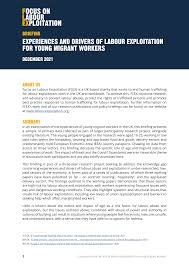By James Robertson
There is evidence suggesting that a large part of the British public has a relatively narrow view of modern slavery, why it's happening, where it's happening, and who’s involved. This view shapes perspectives on what should be done about modern slavery, which tend to focus on punishing the perpetrators and supporting those at risk to better avoid exploitation, whilst leaving out how systemic drivers create the conditions that cultivate and sustain exploitation. There is also growing evidence that language used to describe modern slavery is not accepted by some people with lived experience. The project aimed to identify frames and narratives that would be more effective in increasing the understanding of modern slavery by the British public, enabling a more evidence-based and survivor-informed public debate, and developing language in collaboration with survivors that resonates with survivors of modern slavery in the UK.
Methods: The project first carried out desk-based research to gain an understanding of public perceptions of modern slavery and issues around the framing of modern slavery in the public debate. It then organized a workshop with people with lived experience to identify what they wanted the public to understand about modern slavery and what language should be used. The project developed messages and tested them in three focus groups with members of the British public, led by a research company (Survation). It then brought back experts by experience together to gather their views on the messages and the questions raised by the focus groups.
Key findings:
Drama triangle dominates the narrative on modern slavery – and masks the complexity of it
Modern slavery is often framed in a way that evokes the relationships in the so-called drama triangle, in which the government (the hero) is cracking down on the villains (evil gangs of people smugglers) who are kidnapping the victims of (women from overseas) who are being sexually exploited. The government (the heroes) are doing their best to rescue these ‘slaves’ (victims). The drama triangle masks the breadth and complexity of modern slavery.
The public has a broader understanding of modern slavery but the drama triangle shapes the primary associations.
On the whole, the British public’s understanding of modern slavery is somewhat broader and more nuanced than the common media narrative outlined above. However, the dominant associations do tend to align with the media narratives, that while modern slavery happens in the UK, it primarily affects people trafficked to this country by gangs into exploitation behind closed doors.
Outlining how specific policies increase the risk of exploitation can help reduce the blame placed on individuals
Outlining how policy choices made by the government create conditions that put people at risk can shift the emphasis toward the structural drivers of modern slavery and set up a conversation around how policy change is part of the solution. The more specific the messages were about both the policy problem and the policy solution, the more receptive the public was to the message. However, a great deal of emphasis by the public was still placed on the characteristics of ‘vulnerable’ individuals and the need for them to change; to ‘be more educated’ and ‘to know what to look out’ for.
Dominant narratives around immigration and crime shape understandings and attitudes to modern slavery
By far the most powerful narrative that seemed to block or get in the way of shifting blame away from survivors as if they are ‘illegal migrants’. Even if the public was sympathetic to how ‘desperate’ their situation was and how much they disagreed with the government’s immigration or labor policies, some expressed that people were ‘complicit’ with their exploitation because they broke the law either entering or once in the UK.
Evoking empathy can help shift public attitudes toward modern slavery
The research suggests that using shared values and simple, relatable language to evoke empathy with people experiencing trafficking can be used to disrupt or temporarily dislodge the blocking narrative around ‘illegal migration’. For example, a message that opened with the shared value of “No matter who you are or where you're from, wanting to guarantee the health and well-being of your family is as ordinary as breathing” before asking the public to “imagine if you worked non-stop and still couldn't afford to send your child to school or get your mum the medical help she needs”, was well received by the focus groups, shifting blame away from survivors, as it built empathy for people whose circumstances necessitated making some very difficult choices.
The term ‘victim’ evokes pity - not empathy - amongst the public and is disempowering for people with lived experience
The terms used to describe people who’ve experienced exploitation seemed to have an effect on the empathy the public felt towards survivors and their attitudes towards their role in tackling modern slavery. Amongst the public, ‘victim’ evoked sympathy rather than empathy, whereas ‘survivor’ evoked respect for the individual's strength and resilience. ‘Person with lived experience’ elicited that such a person had a role in leading change. This correlated with the preferences of people with lived experience who found the term ‘victim’ disempowering and warned that the term ‘survivor’ can be gendered and associated with particular forms of exploitation (particularly sexual exploitation) and an obligation to share traumatic stories.
Modern slavery is not a neutral frame
It is important to keep in mind that ‘modern slavery’ is in itself a frame, a metaphor likening multiple contemporary forms of exploitation to the transatlantic slave trade and triggering an association with the commonly used drama triangle.
This frame has been used by the government since before the introduction of the Modern Slavery Act to cast itself in a particular light and in doing so helped to obscure a more complex picture of the issue, including the impact of a “hostile environment” for migrants, which put people at greater risk of exploitation.
Communicators seeking to fill the gaps around the public's understanding of modern slavery must be mindful of this and act accordingly. This may not mean abandoning the term modern slavery altogether, but it does mean understanding that it is not a neutral frame.
2024. 36p.












